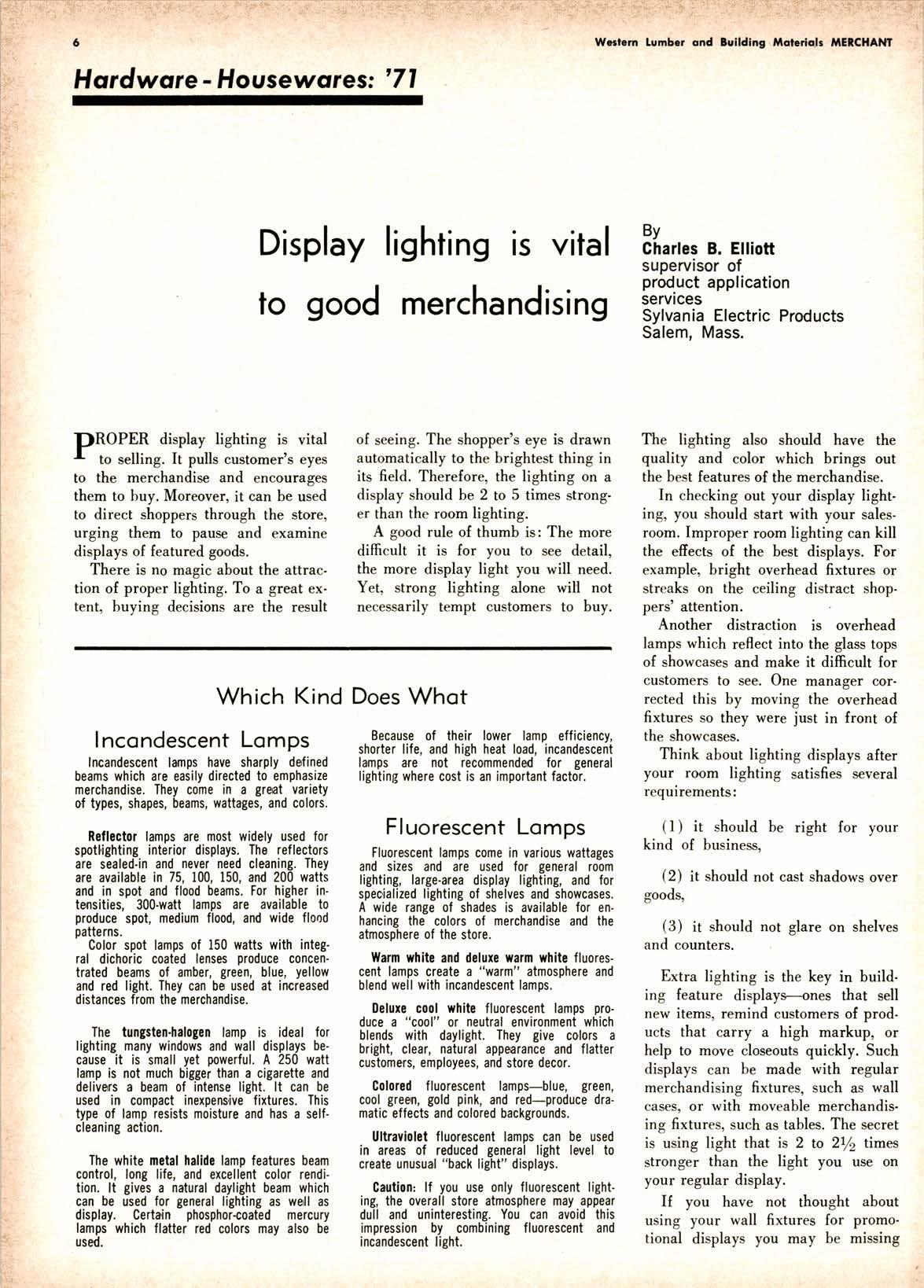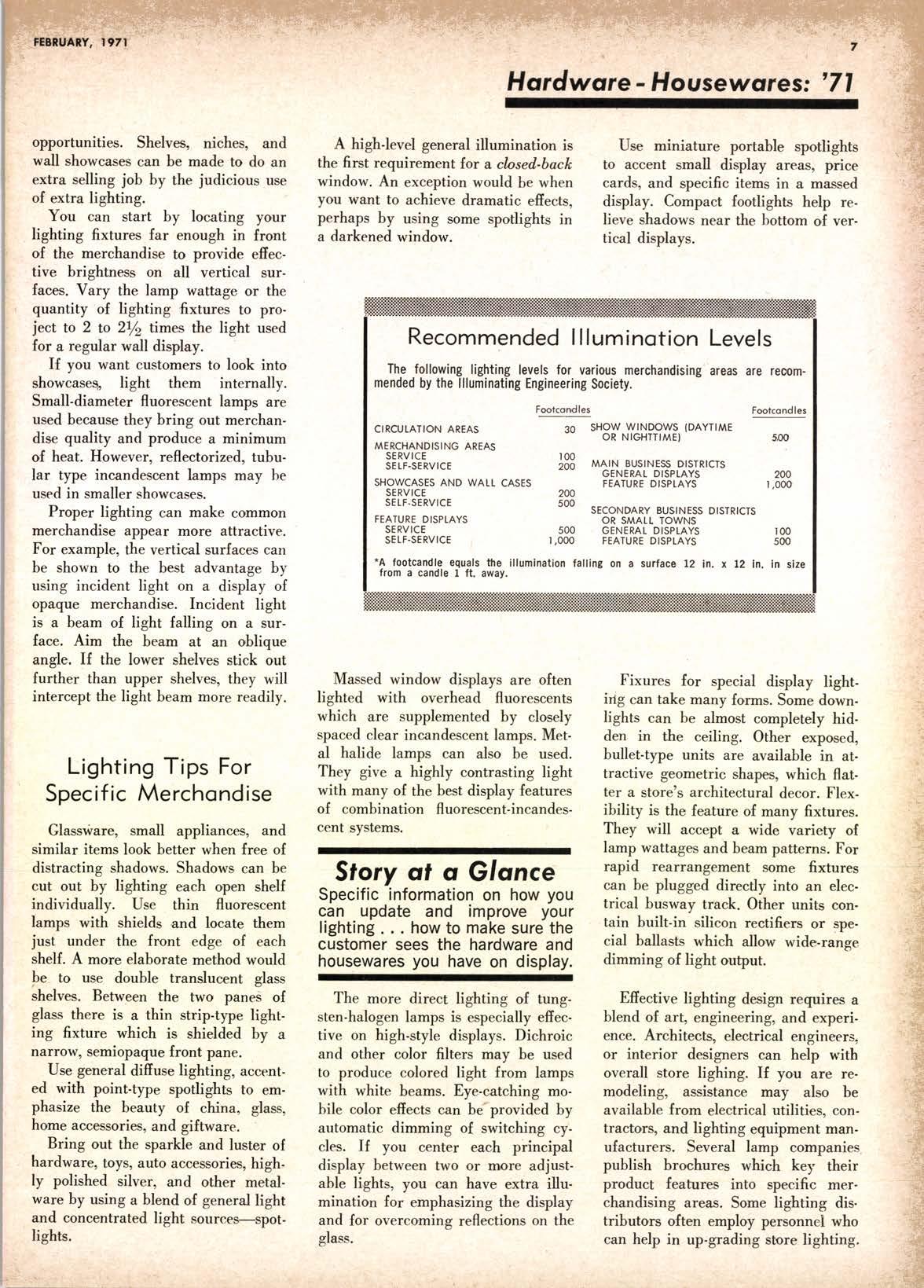
6 minute read
Display lishtine good merchandising
pROPER display lighting is vital r to selling. It pulls customer's eyes to the merchandise and encourages them to buy. Moreover, it can be used to direct shoppers through the store, urging them to pause and examine displays of featured goods.
There is no magic about the attrac. tion of proper lighting. To a great extent, buying decisions are the result
Which Kind
Incondescent Lomps
lncandescent lamps have sharply derfined beams which are easily directed to emphasize merchandise. They come in a grent variety of types, shapes, beams, wattages, and colors.
Reflector lamps are most widely used for spotlighting interior displays. The reflectors are sealed-in and never need cleaning. They are available in 75, 100, 150, and 200 watts and in spot and flood beams. For higher internsities, 300-watt lamps are available to produce spot, medium flood, and wide flood patterns.
Color spot lamps of 150 watts with integral dichoric coated lenses produce concentrated beams of amber, green, blue, yellow and red light. They can be used at irrcreased distances from the merchandise.
The tungsten-halogen lamp is ideal for lighting many windows and wall displays because it is small yet powerful. A 250 watt lamp is not much bigger than a cigarette and deliverrs a beam of intense light. lt can be used in compact inexpens,ive fixtures. This type of lamp resists moisture and has a selfcleaning action.
The white metal halide lamp features beam control, long life, and excellent color rendition. lt gives a natural daylight beam which can be used tor general lighting as werll as display. Certain phosphorroated mercury lamps which flatter red colors may also be used.
of seeing. The shopper's eye is drawn automatically to the brightest thing in its field. Therefore, the lighting on a display should be 2 to 5 times stronger than the room lighting.
A good rule of thumb is: The more difficult it is for you to see detail, the more display light you will need. Yet, strong lighting alone will not necessarily tempt customers to buy.
Does Whot
Because of their lower lamp efficiency, shorter life, and high heat load, incandescent lamps are not recommended for general lighting where cost is an important factor.
Fluorescent Lomps
Fluorescent lamps come in various wattages and sizes and are used for general room lighting, large-area display lighting, and for spec,ialized lighting of shelves and showcases. A wide range of shades is available for enhancing the colors of merchandise and the atmosphere of the store.
Warm white and deluxe warm while fluorescent lamos create a "warm" atmosohere and blend well with incandescent lamps.
Deluxe cool white fluorescent lamps produce a "cool" or neutral environment which blends with daylight. They give colors a bright, clear, natural appmrance and flatter customers, employees, and store decor.
Colored fluorescent lamps-blue, green, cool greer, gold pink, and red-produce dramatic effects and colored backgrounds.
Ultrayiolet fluorescent lamos can be used in areas of reduced general light le'vel to create unusual "back light" displays.
Caution: lf you use only fluorescent lighting, the overall store atmosphere may appear dull and uninteresting. You can avoid this impression by combining fluorescent and incandescent light.
By Charles B. Elliott supervisor of prod.uct application servrces Sylvania Electric Products Salem, Mass.
The lighting also should have the quality and color which brings out the best features of the merchandise.
In checking out your display lighting, you should start with your salesroom. Improper room lighting can kill the effects of the best displays. For example, bright overhead fixtures or streaks on the ceiling distract shoppers' attention.
Another distraction is overhead lamps which reflect into the glass tops of showcases and make it difficult for customers to see. One manager corrected this by moving the overhead fixtures so they were just in front of the showcases.
Think about lighting displays after your room lighting satisfies several requirements:
(l) it should be right for your kind of business,
(2) it should not cast shadows over goods,
(3) it should not glare on shelves and counters.
Extra lighting is the key in build. ing {eature displays-ones that sell new items, remind customers of prod. ucts that carry a high markup, or help to move closeouts quickly. Such displays can be made with regular merchandising fixtures, such as wall cases, or with moveable merchandising fixtures, such as tables. The secret is using light that is 2 to 2r/2 times stronger than the light you use on your regular display.
If you have not thought about using your wall fixtures for promotional displays you may be missing opportunities. Shelve, niches, and wall showcases can be made to do an extra selling job by the judicious use of extra lighting. lf you want customers to look into showcaseg light them internally. Small-diameter fluorescent lamps are used because they bring out merchandise quality and produce a minimum of heat. However, reflectorized, tubular type incandescent lamps may be used in smaller showcases.
You can start by locating your lighting fixtures far enough in front of t}le merchandise to provide efrective brightness on all vertical surfaces. Vary the lamp wattage or the quantity of lighting fixtures to project to 2 to 2r/z times the light used for a regular wall display.
Proper lighting can make common merchandise appear more attractive. For example, the vertical surfaces can be shown to the best advantage by using incident light on a display of opaque merchandise. Incident light is a beam of light falling on a surface. Aim the beam at an oblique angle. If the lower shelves stick out further than upper shelves, they will intercept the light beam more readily.
Lighting Tips For Specific Merchondise
Glass*are, small appliances, and similar items look better when free of distracting shadows. Shadows can be cut out by lighting each open shelf individuallv. Use thin fluorescent lamps with shields and locate them just under the front edge of each shelf. A more elaborate method would be. to use double transluoent glass shelves. Between the two panes of glass there is a thin strip-type lighting fixture which is shielded by a narrow, semiopaque front pane.
Use gerreral difiuse lighting, accented with point.type spodights to em. phasize the beauty of china, glass, home accessories, and giftware.
Bring out the sparkle and luster of hardware, toys, auto accessories, highly polished silver, and other metalware by using a blend of general light and concentrated light sources----€potlights.
Hardwore - Housewqres: '71
A highJevel general illumination is the first requirement Ior a cbseil-back window. An exception would be when you want to achieve dramatic efrects, perhaps by using some spotlights in a darkened window.
Use miniature portable spotlights to accent small display areas, price cards, and specific items in a massed display. Compact footlights help relieve shadows near the bottom of vertical displays.
Recommended llluminotion Levels
The following lighting levels for various merchandising areas are reoommended by the llluminating Engineering Society.

crRcurATror.r AREAs 30 tt8lr^ilJilffil;l
AREAS
SERVICE SE I.F.SE RVICE SHOWCASES AND WALI- CASES SERVICE SE LF.SERVICE FEATURE DISPTAYS SERVICE SE LF.SERVIC€
DrsrRrcrs
*A footcandle equals tie illumlnation talling on a surface 12 in. x 12 In. In size from a candle I ft. away.
Massed window displays are often lighted with overhead fluorescents which are supplernented by closely spaced clear incandescent lamps. Metal halide lamps can also be used. They give a highly contrasting light with many of the best display features of combination fluorescent-incandescent systems.
Slory s] q Glclnce
Specific information on how you can update and improve your lighting how to make sure the customer sees the hardware and housewares you have on display.
The more direct lighting of tungsten-halogen lamps is especially efiective on high-style displays. Dichroic and other color filters may be used to produce colored light from lamps with white beams. Eye-catching mobile color efiects can be-provided by automatic dimming of switching cy: cles. If you center each principal display between two or more adjustable lights, you can have extra illumination for emphasizing the display and for overcoming reflections on the glass.
Fixures for special display lightirtg can take maay forms. Some downlights can be almost completely hidden in the ceiling. Other exposed, bullet-type units are availa-ble in at tractive geometric shapes, which flatter a store's architectural decor. Flexibility is the feature of many fixtures. They will accept a wide variety of lamp wattages and beam patterns. For rapid rearrangement some fixtures can be plugged directly into an electrical busway track. Other units con. tain built-in silicon rectifiers or s-pe. cial ballasts which allow wide-ran6;e dimming of light output.
Efiective lighting design requires a blend of arg engineering, and experience. Architects, electrical engineers, or interior designers can help with overall store lighing. If you are remodeling, assistance may also be available from electrical utilities, contractors, and lighting equipment manufacturers. Several lamp companies publish brochures which key their product features into specific mer. chandising areas. Some lighting dis. tributors often employ personnel who can help in up-grading store lighting.
Hsrdwqre - Housewares: '7|










